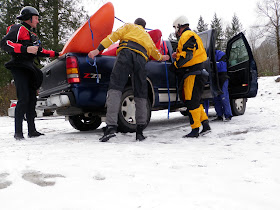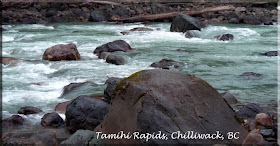For sub-zero paddling there are additional considerations, which have become all the more evident the two times I can really point out where it's become a real issue (not for myself) in my short paddling career thus far. In the winter it can get cold, I've paddled in -6 Celsius temps (and the water felt waaaaaay colder)...to the point you get out and the buckles and zippers on your PFD and equipment have a good layer of ice frozen on them and are impossible to easily open or take off. This is probably not safe and I wouldn't want to do anything exploratory or risky in sub-zero temperatures as the consequences of problems become dire indeed.
Some extra kit I have started wearing since it got around and below 0 degrees are a dry-top full time, fleece top, dry pants, fleece long underwear, wool socks, gortex socks, fleece cap w/ear guards, pogies, and an extra set of neoprene gloves in case of a rescue situation or anything where I won't be holding my paddle and don't want my hands to freeze. I wear this in addition to my wetsuit/surf top and neoprene booties I normally wear in warm weather to this point. Even with all this gear it can get cold and I often will keep paddling in current to keep warm. I highly recommend a drysuit and fleece undergarment...actually at any point, especially in the winter, though they can be expensive..I've managed to this point and for the foreseeable future to find something that works in it's place.
I also always carry, separate from my kit and especially for trips into wilderness, dry clothes (nothing will warm you up when you're cold and wet like getting into something dry, also good to hit a pub or something afterwards), water, warm gloves I can work with and a toque and jacket, just in case. I also always have some basic items like a blanket and sleeping bag permanently in my Jeep as well as towels.
Ever since the whole Independent Power Producer Run of River issue came to my attention (I'll have a whole section/hopefully not rant on this later..) Big Silver Creek has been the one place in it's crosshairs (of MANY) that has really beckoned my attention, between the amazing trip reports on Fraservalleywhitewater.com, Liquidlore.com, Bellinghamwhitewater and others this place looks amazing! ..and is somewhat close to home (compared to most other places someone could live!).
It was finally in early November when a group of us finally assembled to descend upon the river. Merick, Kiah, Matt and myself headed up the long/harsh winter drive along Harrison Lake to the large creek. We had visions of attempting some crazy class IV/IV+ drops, our first waterfalls (there are 7 or so on the length of the river ranging from 10-40 feet tall including one that would be a good first falls in my and other peoples estimations), and running a few of the famous canyons before the place is pilfered by the greedy Independent Power Producers.
Things got off to a bad start, it was windy sometimes with blowing snow, around -1 to -4 degrees, the roads were icy, it was not an ideal time to be exploring and pushing our limits. Three of us had creekboats, one still had a smaller river runner not ideal for some of the things we wanted to push (nothing wrong with portaging!). We got up to the forest service road heading to the river and Merick's car couldn't make the hill, it was too icy. Being persistent as we were we piled all the gear, boats and people into my Jeep and headed up, this meant we no longer had a shuttle...so whatever we were to run we'd have to hike/run/whatever back to the Jeep at the end! ..and adventure right! This would be the least of our problems.
By the time we finally got to the river after seeing Cogburn Creek (another nice looking future easier creek to run!) it was much later in the day than we wanted to be. First mission, check things out...we hiked down a very steep, slippery bank and explored 'Divided we Falls' waterfall, including the unrunnable sieve about 150 yards downstream. What a beautiful waterfall, it seemed clean and flushing, had a few good lines, not a horrible lead in with a pool above and seemed perfectly runnable to finish off a canyony section of the river. It took us a long time to check it out as it was no easy task to get down there (I don't think we were in a rush to get into our boats with the temps!).
Finally, after exploring upstream quite a bit (to where it looks like they intend to place the run-of-river diversion head) we headed down below to the regular put-in for Claudia's 'upper run' in her guidebook (Whitewater in Southwest BC, the local river sub class IV bible). We got in and were freezing...after a fairly short float to an awesome looking, challenging class IV ish rapid leading into a canyon section that looked good to run at the level if slightly low, we got out to scout. A member of our group didn't bring any hand protection, no pogies or gloves, and my extra gloves (which have since been replaced with better, beefier ones) didn't cut it for him. His hands were frozen, especially with the wind, he couldn't go on and got out to do the hike back to The Jeep. We looked at the rapid and thought about it for a long time. We decided to err on the side of caution and get out. It was cold, very cold, we lost our best boater, running the drop meant somewhat committing into a canyon section. If things went wrong it would not be good. We headed up the bank to the road and Merick and I started racing back to the Jeep. This would be our shortest, least productive expedition, weather conspired against us, and it just didn't work out that day, but that's ok.
Though I wish we'd got to run more I'd still deem the expedition a success for 2 simple reasons. Number one, we got to check out an area that not many people get to, a beautiful place worth exploring and that to truly encourage the government to stop it's destruction we need to use and appreciate. We got to scout quite a bit so that when we do go back in warmer weather we'll have a quicker time getting our bearings and heading where we need to go/knowing what we need to do.
The number one reason I'd call the trip a success is because of Clear Creek Hotsprings (a natural, harnessed hotspring, this ain't no Radium!). After our failed attempt at running the river we headed up to the hotsprings (about an hour drive, need a good 4x4), we only found them because of some people we ran into on the way, and it was about -10, dark and near 6 PM when we got up there, but they were amazing, we spent a good hour + there before driving down and unwinding with a delicious meal at Jack's(?) in Agassiz. Like most of the paddling daytrips I've gone on, by the time I got home it was near midnight and I was wiped out. ...waaay better than sitting on the couch watching TV any day of the week!
My coldest paddling day (-6 or so)

























